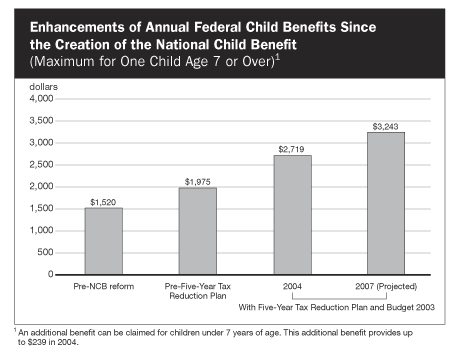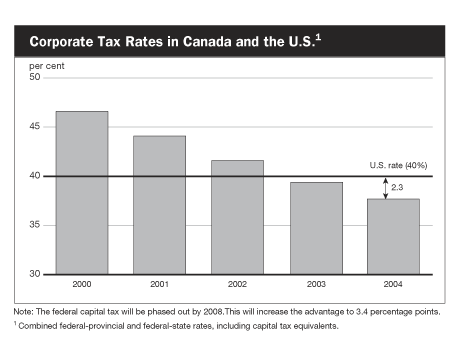![]()
Budget 2004 - Budget Plan
- Table of Contents - Previous
- Next -
Annex 1
Update on Federal Tax Reductions
Introduction
Tax reductions and improvements to Canada’s tax system over the past decade have played an important role in strengthening Canada’s social foundations and building a 21st century economy.
With the elimination of the deficit in 1997, tax relief was provided in the1998 and 1999 budgets. In 2000 the Five-Year Tax Reduction Plan—a plan upon which subsequent budgets have built—was introduced.
In reducing taxes, the approach has been to take fiscally sustainable action that contributes to improving the standard of living and quality of life of all Canadians. Broad-based tax relief benefited first those who needed it most, in particular low-income families with children. Targeted measures for students and persons with disabilities further enhanced the fairness of the tax system.
Tax actions also contributed to establishing the conditions for economic growth and job creation. A fair, efficient and competitive tax system plays akey role in creating a stronger, more productive economy by improving incentives to work, save and invest; supporting entrepreneurship and small business; and fostering the creation and expansion of dynamic firms that can take on the world.
This annex reviews recent tax relief measures and provides an update on how they support Canada’s social and economic goals by:
- Providing personal income tax relief to all Canadians and targeting relief to those who need it most.
- Encouraging entrepreneurship and small business.
- Creating a Canadian advantage for attracting investment and levelling the playing field for firms in all sectors.
Personal Income Tax Relief
By the end of 2004–05, the Five-Year Tax Reduction Plan will have reduced taxes by $100 billion over five years—the largest tax cut in Canadian history.
About three-quarters of this benefit is flowing to individuals, with most of the tax relief going to low- and modest-income Canadians. By the coming fiscal year, the tax reduction plan will have reduced federal personal income taxes by 21 per cent on average and 27 per cent for families with children. Under the plan:
- Personal income tax rates for all taxpayers were lowered effective January 1, 2001.
- The Canada Child Tax Benefit (CCTB) was substantially increased to help low- and middle-income families with children.
- Full indexation was restored to the personal income tax system as of January 1, 2000. It ensures that household gains from tax reductions and benefit increases are permanent. This benefits lower-income Canadians the most.
Budget 2003 built on the Five-Year Tax Reduction Plan by providing additional support for families with children, bringing the maximum benefit for a first child under the CCTB to a projected $3,243 in 2007, more than double the 1996 level of $1,520 (see chart below).
The actions taken since 2000 have also removed about 1 million low-income Canadians from the tax rolls.

As Table A1.1 and the box on the next page show, these measures will provide significant tax relief to Canadians this year.
Table A1.1
Personal Income Tax Relief
|
|
|||
| 2003 | 2004 | Subsequent years | |
|---|---|---|---|
|
|
|||
| (dollars) | |||
| Personal amounts and bracket thresholds | |||
| Basic personal amount | 7,756 | 8,012 | Indexed |
| 22-per-cent bracket threshold | 32,183 | 35,000 | Indexed |
| 26-per-cent bracket threshold | 64,368 | 70,000 | Indexed |
| 29-per-cent bracket threshold | 104,648 | 113,804 | Indexed |
| Canada Child Tax Benefit (CCTB) and National Child Benefit (NCB) supplement1 | |||
| First child maximum2 | 2,632 | 2,719 | Indexed. To be increased4 |
| Second child maximum2 | 2,423 | 2,503 | Indexed. To be increased4 |
| Third child and subsequent children maximum2,3 | 2,427 | 2,507 | Indexed. To be increased4 |
| CCTB phase-out rate | 5% (2.5% for families with one child) | 4% (2% for families with one child) | 4% (2% for families with one child) |
| Family net income at which NCB supplement phase-out ends and CCTB phase-out begins | 33,487 | 35,000 | Indexed |
| Child Disability Benefit1,5 | |||
| Maximum benefit | 1,600 | 1,653 | Indexed |
|
|
|||
| 1 Paid on a benefit-year cycle
beginning in July.
2 An additional benefit can be claimed for children under 7 years of age. This additional benefit provides up to $239 in 2004. 3 Includes additional benefit for third child and subsequent children of $82 in 2003 and $84 in 2004.4 NCB supplement increased by $150 in July 2003, and to be increased by $185 in July 2005 and $185 in July 2006 as per Budget 2003. 5 Took effect in July 2003, but payable in March 2004 (including a retroactive payment for the July 2003 to March 2004 period). |
|||
| Personal Income Tax Relief in 2004
As shown in Table A1.1, tax measures introduced since 2000 will continue to provide significant tax relief to individuals and families. Compared to what taxes would have been in 2004 without the actions that were taken:
Tax reductions and benefit enhancements since 2000 provide that families with children typically do not pay net federal tax—their benefits exceed any tax payable—until their income approaches about $35,000. |
In addition, Canadians benefit from the significant reduction in employment insurance (EI) rates in recent years. This year’s reduction to $1.98 from $2.10 in 2003 represents the 10th consecutive year in which the EI premium has been reduced.
Budget 2004 proposes additional tax relief for persons with disabilities, caregivers and Canadians pursuing lifelong learning. It also builds on prior actions for families with children by helping them accumulate savings for their children’s post-secondary education as a key means of encouraging improved economic and social outcomes for all Canadians.
Entrepreneurship and Small Business
Entrepreneurs and small businesses are important sources of innovation, job creation and economic growth. The tax system can support the growth of small businesses by encouraging them to retain more of their earnings and by enhancing opportunities and incentives for investors, such as venture capital funds, to invest in small enterprises. For these reasons, the tax system provides considerable support to small business. This includes a number of tax measures introduced in recent years. For example:
- The small business capital gains rollover was introduced in 2000 and expanded in 2003 to make it easier for small businesses to access the risk capital needed to expand and grow.
- The federal capital tax, which is being phased out over a five-year period for large businesses, has been completely eliminated in 2004 for smaller businesses.
- To support savings and investment, and to better meet the retirement savings needs of Canadians, including small business owners, the annual registered retirement savings plan (RRSP) contribution limit is being increased from $13,500 in 2002 to $18,000 by 2006. The limit for 2004 is $15,500. Corresponding increases apply to the benefit and contribution limits for registered pension plans (RPPs).
- The capital gains inclusion rate was reduced to one-half as of October 18, 2000.
The 2003 budget increased the amount of income eligible for the 12-per-cent small business rate from $200,000 to $300,000 over four years.This budget proposes to accelerate this initiative, providing small businesses access to the full $300,000 limit for 2005.
Budget 2004 improves the tax system further by allowing businesses to deduct over a longer period the losses they may incur, and removes a potential tax impediment for small businesses that conduct research and development and that raise funds from common investors not acting together.
As Table A1.2 shows, these measures will provide significant additional support for entrepreneurs and small business this year.
Table A1.2
Measures for Entrepreneurship and Small Business
|
|
|||
| 2003 | 2004 | Subsequent years | |
|---|---|---|---|
|
|
|||
| Small business deduction limit | $225,000 | $250,000 | Rises to $300,000 in 2005 |
| Federal capital tax threshold | $10 million | $50 million | Capital tax eliminated for larger businesses in 2008 |
| RRSP limit1 | $14,500 | $15,500 | Rises to $18,000 by 2006 and indexed to average wage growth thereafter |
|
|
|||
| 1 Corresponding increases apply to the benefit and contribution limits for RPPs. | |||
The Canadian Advantage
A number of steps have been taken to improve the competitiveness of the tax system and level the playing field so that firms in all sectors will face similar statutory income tax rates.
A competitive tax system helps economic growth and job creation by encouraging business investment. With more and better equipment embodying the latest technology, workers are more productive. Increased investment and higher labour productivity in turn lead to higher wages and increased employment.
Improving the competitiveness of the tax system is particularly important in attracting and retaining capital at a time when most industrialized countries are significantly reducing their corporate tax rates.
|
Recent International Developments in Corporate Tax Rates
|
Before 2000 only certain sectors, such as manufacturing and processing, had access to tax rates that were by and large internationally competitive. Other firms, including smaller, innovative firms in the fast-growing service sector, faced a higher general corporate income tax rate. As a result of the actions taken in 2000 and 2003, rates were lowered so that firms in all sectors will pay the same statutory rate of tax.
As the chart below shows, with these changes, Canada’s average (federal-provincial) corporate tax rate, including capital taxes, is now 2.3 percentage points lower than the average U.S. (federal-state) rate.
Federal tax relief measures contributing to the Canadian advantage include the following:
- The 28-per-cent general corporate income tax rate has been reduced to 21 per cent.
- The 21-per-cent rate is being extended to the resource sector, along with other improvements to that sector’s tax structure, with the phasing-in being completed by 2007.
- The federal capital tax is being phased out over a five-year period starting in 2004.
These measures will help improve the competitiveness of our tax system and enhance the advantage for business in Canada so that firms can invest, grow, compete globally and create jobs (see box on next page).
Budget 2004 brings improvements to certain capital cost allowance (CCA) rates to ensure that they reflect the useful life of assets and provide adequate recognition of cost, thus establishing the right conditions for productivity-enhancing investment. Proposed adjustments to CCA rates in this budget relate to computers and data network infrastructure equipment.

|
The Canadian Tax Advantage
|
Going Forward
These efforts to improve the tax system have been an integral element in a balanced mix of initiatives to improve the standard of living of Canadians. Since early 2001 Canada has had the strongest employment growth of any G-7 country. Canada has created 838,000 jobs over this period, versus a loss of 2.3 million jobs in the U.S.
Going forward, the Government remains committed to targeted tax reductions, anchored in a sound fiscal plan, that best contribute to strengthening Canada’s social foundations and building a 21st century economy.
- Table of Contents - Previous - Next -
|
|
|||||
| Last Updated: 2004-03-23 | |||||